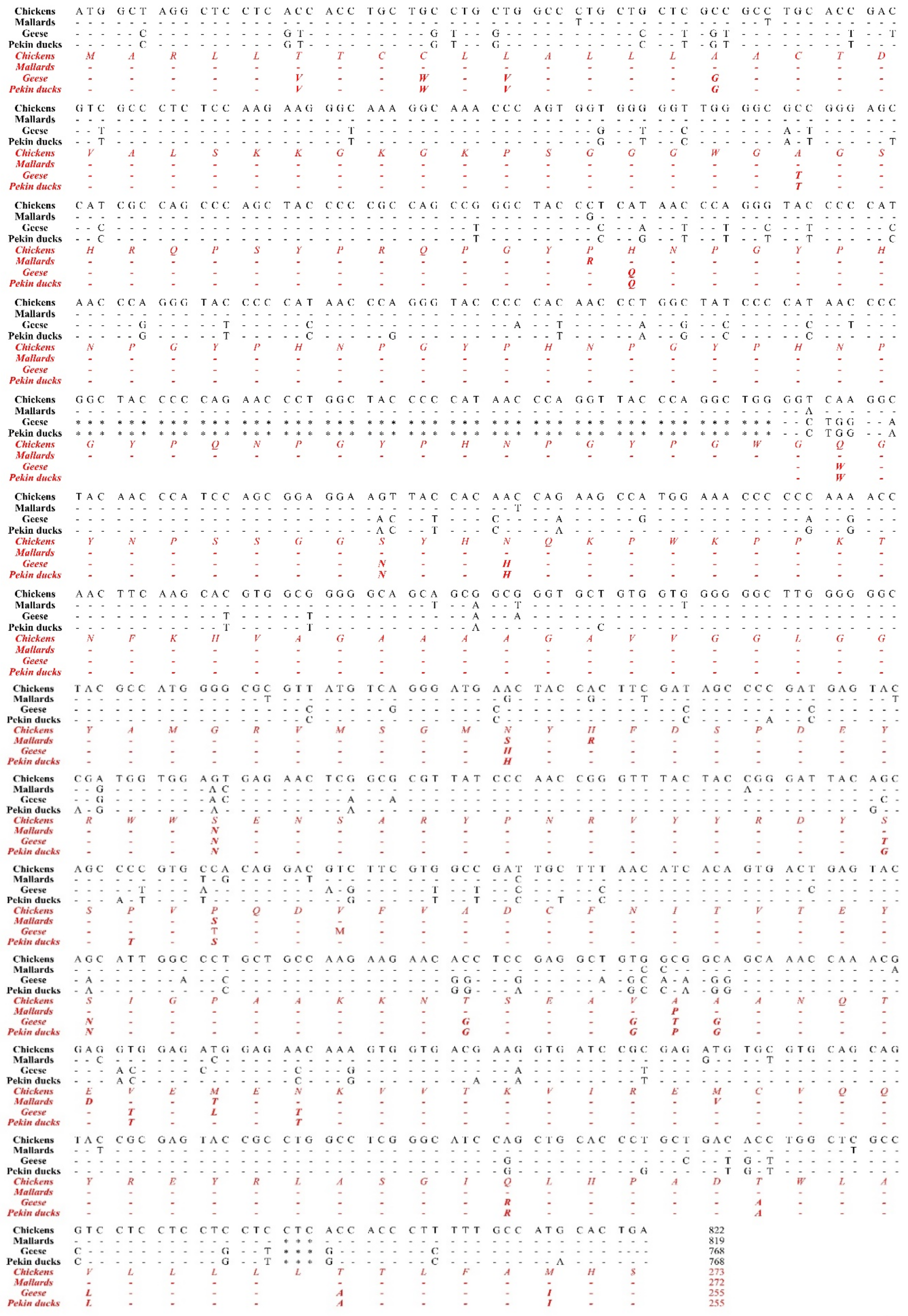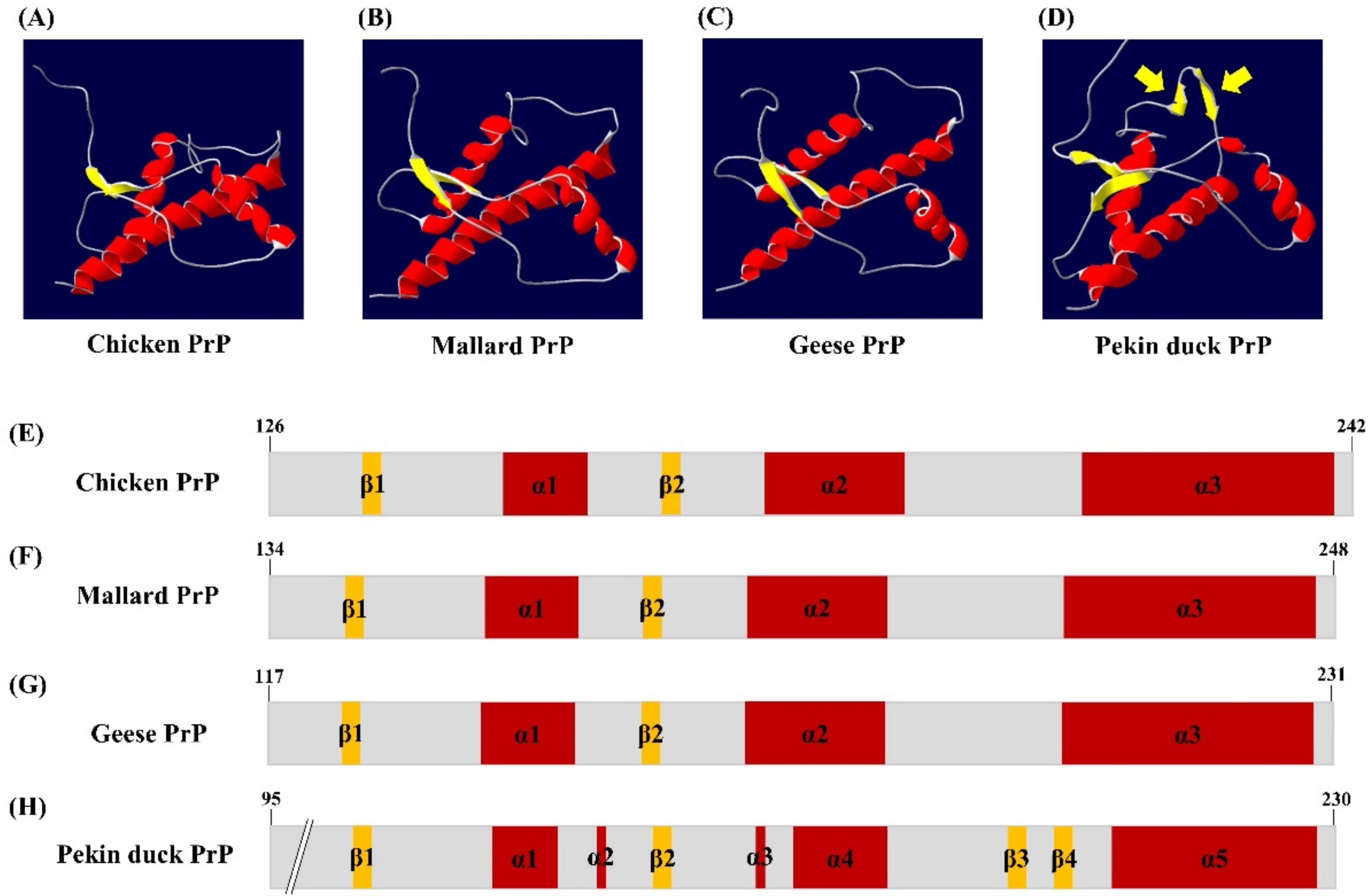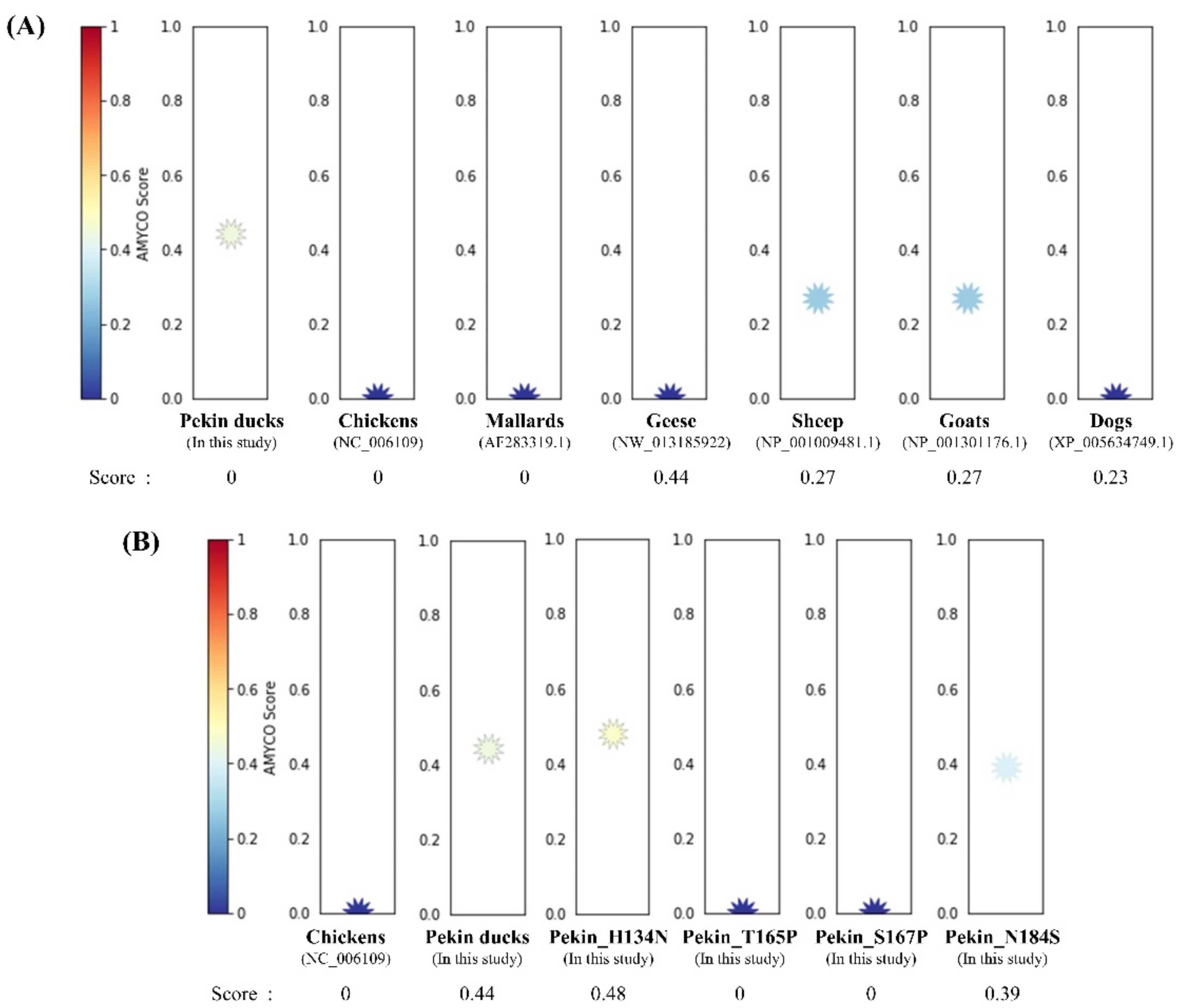The First Report of the Prion Protein Gene (PRNP) Sequence in Pekin Ducks (Anas platyrhynchos domestica): The Potential Prion Disease Susceptibility in Ducks
Abstract
:1. Introduction
2. Materials and Methods
2.1. Samples
2.2. Primer Design and Amplification of the Duck PRNP Gene
2.3. Multiple Sequence Alignments and Phylogenetic Analyses
2.4. Modeling of the Tertiary Structure of Avian PrP
2.5. Prediction of the Aggregation Propensity of Avian PrP
3. Results
3.1. Identification of the PRNP Sequence in Pekin Ducks
3.2. Sequence Alignments and Phylogenetic Analyses of PrP in Several Species
3.3. Analysis of the Tertiary and Secondary Structures of the Pekin Duck PrP
3.4. Evaluation of the Aggregation Propensities in Avian PrPs
4. Discussion
5. Conclusions
Supplementary Materials
Author Contributions
Funding
Institutional Review Board Statement
Data Availability Statement
Conflicts of Interest
Abbreviations
| PRNP | Prion protein gene |
| PrPSc | Pathogenic abnormal prion protein |
| PrPC | normal prion protein |
| BSE | Bovine Spongiform Encephalopathy |
| FSE | Feline Spongiform Encephalopathy |
| MEGA | Molecular Evolutionary Genetics Analysis |
| NCBI | National Center for Biotechnology Information |
| ORF | Open reading frame |
| PCR | Polymerase Chain Reaction |
| GMQE | Global Model Quality Estimation |
| QMEAN | Qualitative Model Energy ANalysis |
| PDB | Protein Data Bank |
| PrP | Prion protein |
References
- Prusiner, S.B. Prions. Proc. Natl. Acad. Sci. USA 1998, 95, 13363–13383. [Google Scholar] [CrossRef] [Green Version]
- Baylis, M.; Goldmann, W. The genetics of scrapie in sheep and goats. Curr. Mol. Med. 2004, 4, 385–396. [Google Scholar] [CrossRef]
- Kim, S.-K.; Kim, Y.-C.; Won, S.-Y.; Jeong, B.-H. Potential scrapie-associated polymorphisms of the prion protein gene (PRNP) in Korean native black goats. Sci. Rep. 2019, 9, 1–10. [Google Scholar] [CrossRef] [Green Version]
- Jeong, B.-H.; Lee, K.-H.; Kim, N.-H.; Jin, J.-K.; Kim, J.-I.; Carp, R.I.; Kim, Y.-S. Association of sporadic Creutzfeldt–Jakob disease with homozygous genotypes at PRNP codons 129 and 219 in the Korean population. Neurogenetics 2005, 6, 229–232. [Google Scholar] [CrossRef]
- Jeong, B.-H.; Jin, H.-T.; Carp, R.I.; Kim, Y.-S. Bovine spongiform encephalopathy (BSE)-associated polymorphisms of the prion protein (PRNP) gene in Korean native cattle. Anim. Genet. 2012, 44, 356–357. [Google Scholar] [CrossRef] [PubMed]
- Biohaz, E.P.O.B.H.; Ricci, A.; Allende, A.; Bolton, D.; Chemaly, M.; Davies, R.; Escámez, P.S.F.; Gironés, R.; Herman, L.; Koutsoumanis, K.; et al. Chronic wasting disease (CWD) in cervids. EFSA J. 2017, 15, e04667. [Google Scholar] [CrossRef]
- Jeong, H.-J.; Lee, J.-B.; Park, S.-Y.; Song, C.-S.; Kim, B.-S.; Rho, J.-R.; Yoo, M.-H.; Jeong, B.-H.; Kim, Y.-S.; Choi, I.-S. Identification of single-nucleotide polymorphisms of the prion protein gene in sika deer (Cervus nippon laiouanus). J. Vet. Sci. 2007, 8, 299–301. [Google Scholar] [CrossRef] [PubMed]
- Pearson, G.R.; Gruffydd-Jones, T.J.; Wyatt, J.M.; Hope, J.; Chong, A.; Scott, A.C.; Dawson, M.; Wells, G.A. Feline spongiform encephalopathy. Vet. Rec. 1991, 128, 532. [Google Scholar] [CrossRef] [PubMed]
- Kim, H.-H.; Kim, Y.-C.; Kim, K.; Kim, A.-D.; Jeong, B.-H. Novel Polymorphisms and Genetic Features of the Prion Protein Gene (PRNP) in Cats, Hosts of Feline Spongiform Encephalopathy. Genes 2020, 12, 13. [Google Scholar] [CrossRef] [PubMed]
- Won, S.-Y.; Kim, Y.-C.; Jeong, B.-H. First Report of the Potential Bovine Spongiform Encephalopathy (BSE)-Related Somatic Mutation E211K of the Prion Protein Gene (PRNP) in Cattle. Int. J. Mol. Sci. 2020, 21, 4246. [Google Scholar] [CrossRef] [PubMed]
- Jeong, B.-H.; Kim, Y.-S. Genetic Studies in Human Prion Diseases. J. Korean Med Sci. 2014, 29, 623–632. [Google Scholar] [CrossRef] [PubMed] [Green Version]
- Pan, K.M.; Baldwin, M.; Nguyen, J.; Gasset, M.; Serban, A.; Groth, D.; Mehlhorn, I.; Huang, Z.; Fletterick, R.J.; Cohen, F.E. Conversion of alpha-helices into beta-sheets features in the formation of the scrapie prion proteins. Proc. Natl. Acad. Sci. USA 1993, 90, 10962–10966. [Google Scholar] [CrossRef] [PubMed] [Green Version]
- Kim, Y.-C.; Won, S.-Y.; Jeong, B.-H. Absence of single nucleotide polymorphisms (SNPs) in the open reading frame (ORF) of the prion protein gene (PRNP) in a large sampling of various chicken breeds. BMC Genom. 2019, 20, 1–7. [Google Scholar] [CrossRef] [PubMed]
- Kim, Y.-C.; Won, S.-Y.; Do, K.-T.; Jeong, B.-H. Identification of the novel polymorphisms and potential genetic features of the prion protein gene (PRNP) in horses, a prion disease-resistant animal. Sci. Rep. 2020, 10, 8926. [Google Scholar] [CrossRef]
- Kim, Y.-C.; Jeong, B.-H. The first report of polymorphisms and genetic characteristics of the prion protein gene (PRNP) in horses. Prion 2018, 12, 245–252. [Google Scholar] [CrossRef] [Green Version]
- Kim, D.-J.; Kim, Y.-C.; Kim, A.-D.; Jeong, B.-H. Novel Polymorphisms and Genetic Characteristics of the Prion Protein Gene (PRNP) in Dogs—A Resistant Animal of Prion Disease. Int. J. Mol. Sci. 2020, 21, 21. [Google Scholar] [CrossRef]
- Kim, Y.-C.; Jeong, M.-J.; Jeong, B.-H. The first report of genetic variations in the chicken prion protein gene. Prion 2018, 12, 197–203. [Google Scholar] [CrossRef] [Green Version]
- Fernández-Borges, N.; Parra, B.; Vidal, E.; Eraña, H.; Sanchez-Martin, M.A.; De Castro, J.; Elezgarai, S.R.; Pumarola, M.; Mayoral, T.; Castilla, J. Unraveling the key to the resistance of canids to prion diseases. PLoS Pathog. 2017, 13, e1006716. [Google Scholar] [CrossRef] [Green Version]
- Otero, A.; Bolea, R.; Hedman, C.; Fernández-Borges, N.; Marín, B.; López-Pérez, Ó.; Barrio, T.; Eraña, H.; Sánchez-Martín, M.A.; Monzón, M.; et al. An Amino Acid Substitution Found in Animals with Low Susceptibility to Prion Diseases Confers a Protective Dominant-Negative Effect in Prion-Infected Transgenic Mice. Mol. Neurobiol. 2018, 55, 6182–6192. [Google Scholar] [CrossRef] [Green Version]
- Sanchez-Garcia, J.; Fernandez-Fúnez, P. D159 and S167 are protective residues in the prion protein from dog and horse, two prion-resistant animals. Neurobiol. Dis. 2018, 119, 1–12. [Google Scholar] [CrossRef]
- Perez, D.R.; Damberger, F.F.; Wüthrich, K. Horse Prion Protein NMR Structure and Comparisons with Related Variants of the Mouse Prion Protein. J. Mol. Biol. 2010, 400, 121–128. [Google Scholar] [CrossRef] [PubMed]
- Kurt, T.D.; Bett, C.; Fernández-Borges, N.; Joshi-Barr, S.; Hornemann, S.; Rülicke, T.; Castilla, J.; Wüthrich, K.; Aguzzi, A.; Sigurdson, C.J. Prion Transmission Prevented by Modifying the β2-α2 Loop Structure of Host PrP C. J. Neurosci. 2014, 34, 1022–1027. [Google Scholar] [CrossRef] [PubMed] [Green Version]
- Zhang, J. The Structural Stability of Wild-type Horse Prion Protein. J. Biomol. Struct. Dyn. 2011, 29, 369–377. [Google Scholar] [CrossRef] [PubMed] [Green Version]
- La Mendola, D.; Pietropaolo, A.; Pappalardo, G.; Zannoni, C.; Rizzarelli, E. Prion Proteins Leading to Neurodegeneration. Curr. Alzheimer Res. 2008, 5, 579–590. [Google Scholar] [CrossRef] [PubMed] [Green Version]
- Calzolai, L.; Lysek, D.A.; Pérez, D.R.; Güntert, P.; Wüthrich, K. Prion protein NMR structures of chickens, turtles, and frogs. Proc. Natl. Acad. Sci. USA 2005, 102, 651–655. [Google Scholar] [CrossRef] [Green Version]
- Wopfner, F.; Weidenhöfer, G.; Schneider, R.; Von Brunn, A.; Gilch, S.; Schwarz, T.F.; Werner, T.; Schätzl, H.M. Analysis of 27 mammalian and 9 avian PrPs reveals high conservation of flexible regions of the prion protein. J. Mol. Biol. 1999, 289, 1163–1178. [Google Scholar] [CrossRef]
- Matthews, D.; Cooke, B. The potential for transmissible spongiform encephalopathies in non-ruminant livestock and fish. Rev. Sci. Tech. OIE 2003, 22, 283–296. [Google Scholar] [CrossRef]
- Moore, S.J.; Hawkins, S.A.; Austin, A.R.; Konold, T.; Green, R.B.; Blamire, I.W.; Dexter, I.; Stack, M.J.; Chaplin, M.J.; Langeveld, J.P.M.; et al. Studies of the transmissibility of the agent of bovine spongiform encephalopathy to the domestic chicken. BMC Res. Notes 2011, 4, 501. [Google Scholar] [CrossRef] [Green Version]
- Cherry, P.; Morris, T.R. Domestic Duck Production: Science and Practice; CABI: Wallingford, UK, 2008. [Google Scholar]
- Broekman, K. The German Pekin Duck; Aviculture Europe: Voorschoten, Netherlands, 2009; Volume 12. [Google Scholar]
- Kim, H.; Kang, B.; HwangBo, J.; Kim, C.; Heo, K.; Choo, H.; Park, D.; Suh, O.; Hong, E. The study on growth performance and carcass yield of meat-type Korean Native Ducks. Korean J. Poult. Sci. 2012, 39, 45–52. [Google Scholar] [CrossRef]
- Kumar, S.; Stecher, G.; Tamura, K. MEGA7: Molecular Evolutionary Genetics Analysis Version 7.0 for Bigger Datasets. Mol. Biol. Evol. 2016, 33, 1870–1874. [Google Scholar] [CrossRef] [Green Version]
- Billeter, M.; Riek, R.; Wider, G.; Hornemann, S.; Glockshuber, R.; Wüthrich, K. Prion protein NMR structure and species barrier for prion diseases. Proc. Natl. Acad. Sci. USA 1997, 94, 7281–7285. [Google Scholar] [CrossRef] [PubMed] [Green Version]
- Hosszu, L.L.P.; Trevitt, C.R.; Jones, S.; Batchelor, M.; Scott, D.J.; Jackson, G.S.; Collinge, J.; Waltho, J.P.; Clarke, A.R. Conformational Properties of β-PrP. J. Biol. Chem. 2009, 284, 21981–21990. [Google Scholar] [CrossRef] [PubMed] [Green Version]
- Tizzano, B.; Palladino, P.; De Capua, A.; Marasco, D.; Rossi, F.; Benedetti, E.; Pedone, C.; Ragone, R.; Ruvo, M. The human prion protein α2 helix: A thermodynamic study of its conformational preferences. Proteins Struct. Funct. Bioinform. 2005, 59, 72–79. [Google Scholar] [CrossRef] [PubMed]
- Ji, H.-F.; Zhang, H.-Y. β-sheet constitution of prion proteins. Trends Biochem. Sci. 2010, 35, 129–134. [Google Scholar] [CrossRef] [PubMed]
- Sigurdson, C.J.; Nilsson, K.P.R.; Hornemann, S.; Manco, G.; Fernández-Borges, N.; Schwarz, P.; Castilla, J.; Wüthrich, K.; Aguzzi, A. A molecular switch controls interspecies prion disease transmission in mice. J. Clin. Investig. 2010, 120, 2590–2599. [Google Scholar] [CrossRef] [Green Version]
- Bett, C.; Fernández-Borges, N.; Kurt, T.D.; Lucero, M.; Nilsson, K.P.R.; Castilla, J.; Sigurdson, C.J. Structure of the β2-α2 loop and interspecies prion transmission. FASEB J. 2012, 26, 2868–2876. [Google Scholar] [CrossRef] [PubMed] [Green Version]
- Harrathi, C.; Fernández-Borges, N.; Eraña, H.; Elezgarai, S.R.; Venegas, V.; Charco, J.M.; Castilla, J. Insights into the Bidirectional Properties of the Sheep–Deer Prion Transmission Barrier. Mol. Neurobiol. 2018, 56, 5287–5303. [Google Scholar] [CrossRef] [Green Version]



| Species | Template | Length (Range) | Distribution of α-Helices | Distribution of β-Sheets | ||
|---|---|---|---|---|---|---|
| Location | Percentage | Location | Percentage | |||
| Chickens | 1U3M | 116 | 151–161, 179–194, | 49.57 | 136–138, 168–170 | 5.13 |
| (126–242) | 213–240 | |||||
| Mallards | 1U3M.1 | 114 | 157–167, 185–200, | 47.83 | 142–144, 174–176 | 5.22 |
| (134–248) | 219–246 | |||||
| Geese | 1U3M.1 | 114 | 140–150, 168–183, | 47.83 | 125–127, 157–159 | 5.22 |
| (117–231) | 202–229 | |||||
| Pekin ducks | 2lft.1.A | 135 | 140–147, 151, 168, | 32.35 | 125–127, 157–159, 195–197, 200–202 | 8.82 |
| (95–230) | 172–182, 206–228 | |||||
| Sequence | Residues | Pekin Duck-Conserved | Chicken-Specific | Score |
|---|---|---|---|---|
| Chickens | Wildtype | 0 | ||
| Pekin ducks | Wildtype | 0.44 | ||
| 80_81ins | - | GYPQNPGYPHNPGYPGW | 0.44 | |
| 6 | Valine | Threonine | 0.44 | |
| 9 | Tryptophan | Cysteine | 0.44 | |
| 11 | Valine | Leucine | 0.44 | |
| 16 | Glycine | Alanine | 0.44 | |
| 38 | Threonine | Alanine | 0.44 | |
| 54 | Glutamine | Histidine | 0.44 | |
| 82 | Tryptophan | Glutamine | 0.44 | |
| 91 | Asparagine | Serine | 0.44 | |
| 94 | Histidine | Asparagine | 0.44 | |
| 134 | Histidine | Asparagine | 0.48 | |
| 147 | Asparagine | Serine | 0.44 | |
| 163 | Glycine | Serine | 0.44 | |
| 165 | Threonine | Proline | 0 | |
| 167 | Serine | Proline | 0 | |
| 184 | Asparagine | Serine | 0.39 | |
| 193 | Glycine | Threonine | 0.44 | |
| 197 | Glycine | Valine | 0.44 | |
| 198 | Proline | Alanine | 0.44 | |
| 199 | Glycine | Alanine | 0.44 | |
| 205 | Threonine | Valine | 0.44 | |
| 209 | Threonine | Asparagine | 0.44 | |
| 234 | Arginine | Glutamine | 0.44 | |
| 240 | Alanine | Threonine | 0.44 | |
| 244 | Leucine | Valine | 0.44 | |
| 248_249ins | - | Leucine | 0.44 | |
| 249 | Alanine | Threonine | 0.44 | |
| 254 | Isoleucine | Methionine | 0.44 |
Publisher’s Note: MDPI stays neutral with regard to jurisdictional claims in published maps and institutional affiliations. |
© 2021 by the authors. Licensee MDPI, Basel, Switzerland. This article is an open access article distributed under the terms and conditions of the Creative Commons Attribution (CC BY) license (http://creativecommons.org/licenses/by/4.0/).
Share and Cite
Jeong, M.-J.; Kim, Y.-C.; Jeong, B.-H. The First Report of the Prion Protein Gene (PRNP) Sequence in Pekin Ducks (Anas platyrhynchos domestica): The Potential Prion Disease Susceptibility in Ducks. Genes 2021, 12, 193. https://doi.org/10.3390/genes12020193
Jeong M-J, Kim Y-C, Jeong B-H. The First Report of the Prion Protein Gene (PRNP) Sequence in Pekin Ducks (Anas platyrhynchos domestica): The Potential Prion Disease Susceptibility in Ducks. Genes. 2021; 12(2):193. https://doi.org/10.3390/genes12020193
Chicago/Turabian StyleJeong, Min-Ju, Yong-Chan Kim, and Byung-Hoon Jeong. 2021. "The First Report of the Prion Protein Gene (PRNP) Sequence in Pekin Ducks (Anas platyrhynchos domestica): The Potential Prion Disease Susceptibility in Ducks" Genes 12, no. 2: 193. https://doi.org/10.3390/genes12020193






